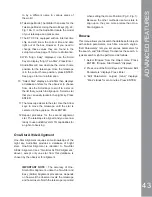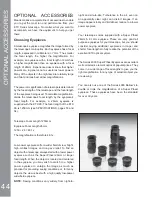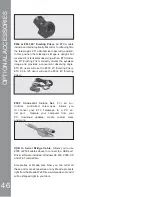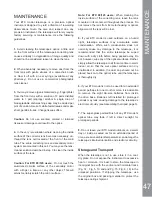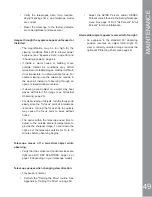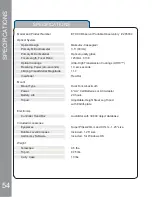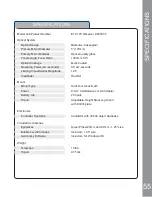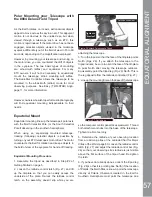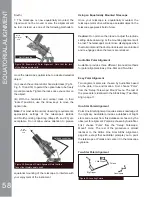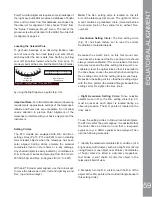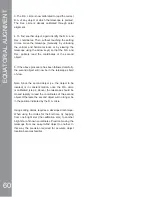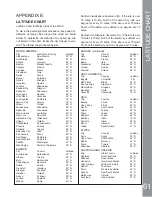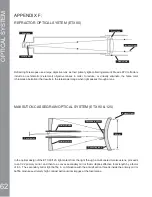
EQUATORIAL (POLAR) ALIGNMENT
**FOR ETX 90/125 ONLY**
APPENDIX D:
Equatorial Alignment
In equatorial (or “polar”) alignment, the telescope is
oriented so that the horizontal and vertical axes of the
telescope are lined up with the celestial coordinate
system.
In order to equatorial align your telescope, it is
essential to have an understanding of how and where
to locate celestial objects as they move across the
sky. This section provides a basic introduction to the
terminology of equatorial-aligned astronomy and
LQFOXGHVLQVWUXFWLRQVIRU¿QGLQJWKHFHOHVWLDOSROHDQG
IRU ¿QGLQJ REMHFWV LQ WKH QLJKW VN\ XVLQJ 'HFOLQDWLRQ
and Right Ascension.
Celestial Coordinates
A celestial coordinate system was created that maps
an imaginary sphere surrounding the Earth upon which
all stars appear to be placed. This mapping system is
similar to the system of latitude and longitude on Earth
surface maps.
In mapping the surface of the Earth, lines of longitude
are drawn between the North and South Poles and
lines of latitude are drawn in an East-West direction,
parallel to the Earth’s equator. Similarly, imaginary
lines have been drawn to form a latitude and longitude
grid for the celestial sphere. These lines are known as
Right Ascension and Declination.
The celestial map also contains two poles and an
equator just like a map of the Earth. The poles of this
FRRUGLQDWH V\VWHP DUH GH¿QHG DV WKRVH WZR SRLQWV
where the Earth’s North and South poles (i.e., the
(DUWK¶V D[LV LI H[WHQGHG WR LQ¿QLW\ ZRXOG FURVV WKH
celestial sphere. Thus, the North Celestial Pole (Fig.
25) is that point in the sky where an extension of the
North Pole intersects the celestial sphere. The North
Star, Polaris, is located very near the North Celestial
Pole). The celestial equator is a projection of the
Earth’s equator onto the celestial sphere.
So just as an object’s position on the Earth’s surface
can be located by its latitude and longitude, celestial
objects may also be located using Right Ascension
and Declination. For example: You could locate Los
Angeles, California, by its latitude (+34°) and longitude
(118°). Similarly, you could locate the Ring Nebula
(M57) by its Right Ascension (18hr) and its Declination
(+33°).
• Right Ascension (R.A.):
This celestial version of
longitude is measured in units of hours (hr), minutes
(min) and seconds (sec) on a 24-hour “clock” (similar
to how Earth’s time zones are determined by longitude
lines). The “zero” line was arbitrarily chosen to pass
through the constellation Pegasus, a sort of cosmic
Greenwich meridian. R.A. coordinates range from 0hr
0min 0sec to 23hr 59min 59sec. There are 24 primary
lines of R.A., located at 15-degree intervals along the
celestial equator. Objects located further and further
East of the zero R.A. grid line (0hr 0min 0sec) carry
higher R.A. coordinates.
• Declination (Dec.):
This celestial version of latitude
is measured in degrees, arc-minutes and arc-seconds
(e.g., 15° 27’ 33”). Dec. locations North of the celestial
equator are indicated with a plus (+) sign (e.g., the
Dec. of the North celestial pole is +90°). Dec. locations
South of the celestial equator are indicated with a
minus (–) sign (e.g., the Dec. of the South celestial
pole is –90°). Any point on the celestial equator (such
as the constellations of Orion, Virgo and Aquarius) is
said to have a Declination of zero, shown as 0° 0’ 0.”
14
15
16
17
18
19
20
21
22
23
0
1
12
11
10
9
8
7
5
6
4
3
2
13
Earth’s
Rotation
0 Dec.
South
Celestial
Pole
Right Ascension
Star
Celestial
Equator
-90 Dec.
+90 Dec.
North
Celestial
Pole
(Vicinity
of Polaris)
D
ec
lin
ati
on
1
2
Figure 25: Celestial Sphere
56
EQUA
T
O
RIAL
ALIGNMENT
56


